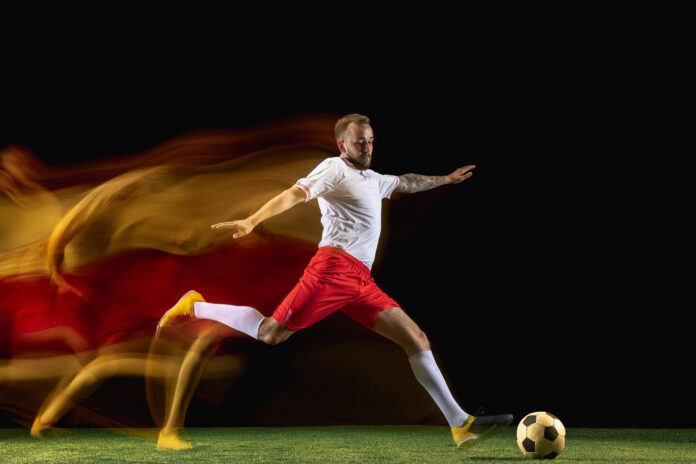Soccer, known as football in many places, is a fast, strategic sport. It relies on player positioning. Each position on the field has a unique purpose. It helps both defense and attack. Understanding these positions and their roles is crucial for players and fans alike. This article will explore traditional soccer positions. It will highlight the roles and the importance of their position numbers in team formation.

Goalkeeper (1)
The goalkeeper is the last line of defense. They must stop the other team from scoring. The goalkeeper, positioned centrally in front of the goal, must stop shots. They can use any part of their body, including their hands and arms, but only within the penalty area. Goalkeepers are often required to have excellent reflexes and agility. They must have a good understanding of positioning to anticipate and block shots.
Goalkeepers do more than stop shots. They organize the defense. They often act as a vocal leader, directing the backline and setting up free-kick walls. In modern soccer, goalkeepers must help with the buildup. They should accurately distribute the ball with throws and kicks to start attacks. This position requires a blend of technical skills, mental toughness, and the ability to read the game.
Defensive Soccer Positions
Defenders are key to the team’s defense. They prevent the other team from scoring. They must stop attacks, mark opponents, and clear the ball from the defensive third. Here’s a look at the different Soccer positions for defenders:
Center Backs (4, 5):
Center backs (RCB, LCB) are at the heart of the defense. They block attacks and win aerial duels. Center Backs must be strong, good at tackling, and skilled at reading the game. They should intercept passes and make key clearances. Center Backs often organize the defense. They work with the goalkeeper to ensure stability.
Fullbacks (2, 3):
Fullbacks (RB, LB), on the flanks of the defense, have a dual role. They must defend against wide attacks and support the offense by providing width. Fullbacks must be quick and able to cover large areas of the field. They often engage in one-on-one duels with opposing wingers. Fullbacks must also make overlapping runs to support the midfield. They should deliver crosses into the attacking area.
Wingbacks:
Wingback (RWB, LWB) is a variation of fullbacks. It is used primarily in formations with three central defenders. They have a more offensive role and must contribute significantly to defense and attack. Wingbacks must have great stamina and speed. As they must cover the entire field. They need to provide crosses, create scoring chances, and defend.
Sweeper (Libero):
The sweeper (SW) plays behind the center backs. They “sweep up” any loose balls that get past the central defenders and provide extra defensive cover. Sweepers need great awareness, anticipation, and passing skills. They start attacks by passing the ball to teammates. While the use of a sweeper has declined in modern soccer, it remains a key role in certain tactical systems.
Midfielder Soccer Positions
Midfielders link defense and attack. They control the game’s tempo and distribute the ball across the field. They are versatile players who contribute to both defensive and offensive plays. Here are the different types soccer positions of midfielders:
Defensive Midfielders (6):
The main role of a Defensive Midfielder (CDM) is to protect the backline. They do this by breaking up opposition attacks with interceptions and tackles. CDM are positioned just in front of the defense. They must win back possession and shield the defenders. As they are often the first line of defense when the team loses possession.
Central Midfielders (8):
Central Midfielders (CM) are the engine of the team. They are responsible for maintaining possession and dictating the pace of play. They need to have excellent passing abilities and vision to pass the ball to teammates. Central midfielders often shuttle between defense and attack, providing support in both areas. They are crucial for transitioning the ball from defense to the attacking third.
Attacking Midfielders (10):
Attacking Midfielders (CAM) operate primarily in the opposition’s half. They are tasked with creating goal-scoring opportunities. Often seen as playmakers, they use their skills to create chances. They dribble and have good vision. They aim to set up forwards and score goals themselves. Attacking midfielders must know the game well. They are key to unlocking defenses and orchestrating attacks.
Wing Midfielder (7, 11):
Wing midfielders (RM, LM) are key. They provide width to the team’s formation. Wing Midfielders must deliver crosses into the attacking area. They should stretch the defense and create space for central players. Wing midfielders are expected to have good dribbling skills, pace, and crossing ability. They support both defensive and offensive plays. They track back to defend against opposing wingers and push forward to attack.
Wide Midfielders (7, 11):
Wide Midfielders (RM, LM) are positioned on the flanks. They are responsible for stretching the play by utilizing the width of the field. Wide Midfielders provide crosses into the box and create space for attackers. They often take on opposing fullbacks in one-on-one situations. Wide Midfielders must be quick and agile. They must deliver accurate crosses and cut inside to create scoring chances.
Attacking Soccer Positions
Forwards are primarily responsible for scoring goals and creating attacking opportunities. They operate in the opponent’s half. They must finish moves and capitalize on teammates’ chances. Here’s a breakdown of the different types of forwards:
Wingers (7, 11):
Wingers (RW, LW) play on the flanks. They are fast and skilled at dribbling and crossing. They stretch the opposition’s defense by providing width and crossing the ball into the penalty area. Wingers often face defenders in one-on-one situations. They then cut inside to create goal-scoring chances for themselves or their teammates. They must control the ball and deliver accurate crosses under pressure.
Strikers (9):
Strikers (ST) are the primary goal scorers. They are positioned closest to the opponent’s goal. They must finish attacks, convert chances into goals, and pressure the defense. Strikers must excel at positioning and finishing. They must also decide quickly in front of the goal. Strikers often operate as the focal point of the attack. They often hold up the ball to bring in other players. They exploit defensive weaknesses to score.
Second Striker:
Also known as a support striker or withdrawn forward. It plays a more versatile and creative role just behind the main striker. They connect the midfield and attack. They often drop deeper to collect the ball, make runs into the box, and create chances for the main striker. Second strikers need good vision and passing skills. They must find space in crowded areas. Their role is to support the main striker. They draw defenders out of position and contribute to both goals and assists.
Conclusion
Understanding soccer positions is essential for appreciating the strategic depth of the game. Each position on the field has a specific role. It contributes to both defense and attack. A team may use different roles depending on the formation. A 4-4-2 may use wing midfielders for width and support. For a 4-2-3-1, it may use attacking midfielders to create chances. Every player is vital to the team’s performance. From the goalkeeper’s crucial saves to the forwards’ goals, they all play a part. Whether you’re a player or a fan, knowing these positions and their duties enhances your appreciation of soccer’s tactics. It adds to the game’s complexity.







